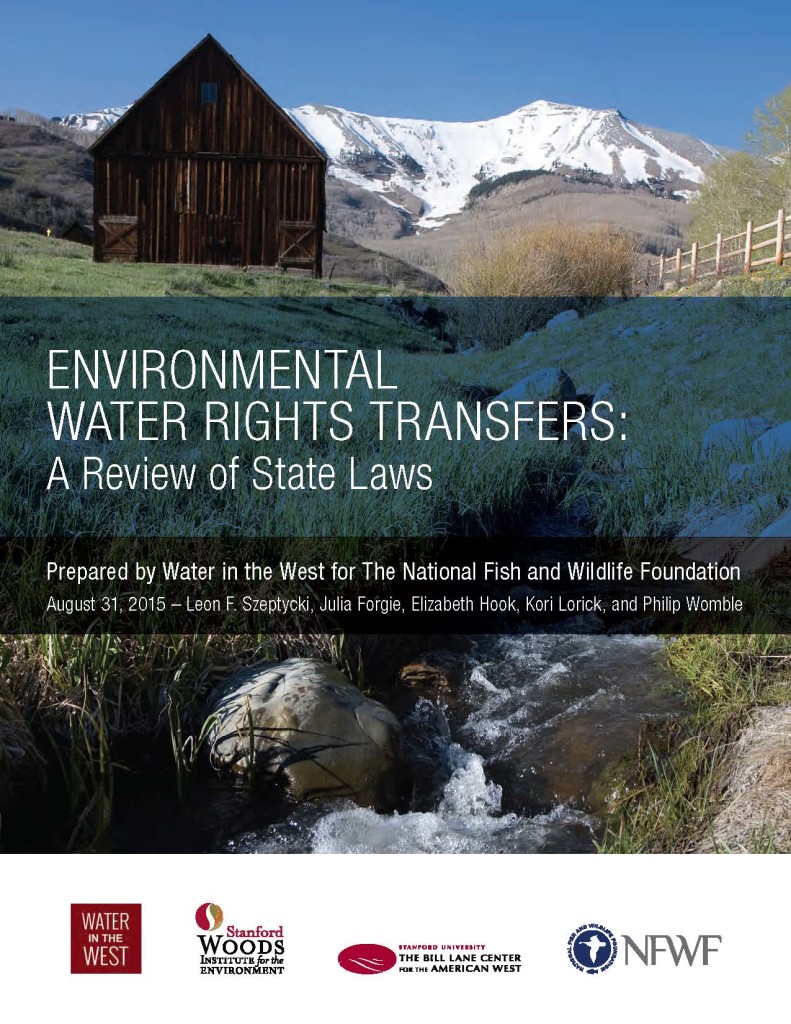California and Other Western States See Barriers to Protecting Streams
A new report highlights twelve western states’ efforts to restore stream flows using environmental water transfers
Unnaturally low flows in rivers and streams throughout the western United States have threatened fish and other aquatic species for decades. But restoring flows has proved a significant and complex challenge. A recent report prepared for the National Fish and Wildlife Foundation by Stanford University’s Water in the West Program documents twelve western states’ efforts to restore stream flows using a relatively recent tool: environmental water transfers. My research for the report focused on California’s transfers. So although this post highlights the report’s key findings, it primarily examines barriers and opportunities for California’s environmental water transfers, especially under drought conditions.
 Historically, western water law provided no incentive to keep water in streams. The prior appropriation system encourages early diversion and economic use of water. The first individual who puts water to a “beneficial use” may acquire a right to that water. But until the 1960s, beneficial uses included only those outside the stream. Fish habitat, recreation, and other environmental uses did not qualify. As state laws began to recognize these uses and protect existing flows, states slowly started to allow transfers or dedications of existing water rights for recreation and wildlife habitat enhancement.
Historically, western water law provided no incentive to keep water in streams. The prior appropriation system encourages early diversion and economic use of water. The first individual who puts water to a “beneficial use” may acquire a right to that water. But until the 1960s, beneficial uses included only those outside the stream. Fish habitat, recreation, and other environmental uses did not qualify. As state laws began to recognize these uses and protect existing flows, states slowly started to allow transfers or dedications of existing water rights for recreation and wildlife habitat enhancement.
Stanford’s report documents the legal mechanisms each state has developed over the past 25 years to facilitate environmental water transfers. These mechanisms vary widely by state and include a range of legal elements. For instance, although all states recognize fish habitat or recreation as beneficial uses, Nevada and New Mexico lack statutes that explicitly recognize transfers of existing rights to these instream uses.
The report concludes, in part, that a greater range of legal elements provides more flexibility and opportunity to facilitate environmental water transfers. And the numbers of transfers in most states corroborate that finding. Except in California.
Among the twelve states, California has the greatest number of relevant legal elements in its provisions. Yet according to the report, it had approved only 34 transfers as of April 2014, including four emergency short-term transfers. Since May 2014, the state has approved two additional emergency short-term transfers, four longer-term transfers, and has two pending applications.[1] So there may be cause for optimism. But a total of 40 transfers over more than 20 years pales compared to the hundreds the report documents in both Oregon and Washington.
Why has California’s apparently robust legal scheme not worked? Practitioners point to perceived and actual administrative hurdles that make environmental water transfers costly and time consuming. There has been a significant time lag between the date a transfer application is filed and the date the state water board approves it. Particularly disconcerting is the seven-month approval delay for non-emergency short-term transfers of less than one year in duration. The report cites state inaction, extensive documentation requirements, the protest process, and uncertainty over the role of CEQA as potential causes for the delay. California also lacks an expedited approval process for any transfers longer than one year.
These hurdles could be minimized through legal and policy changes and clarifications. Expanding expedited review, clarifying which transfers are exempt from CEQA analyses, and building public awareness about the benefits of environmental water transfers, the report concludes, could shorten the approval timeline and facilitate more frequent environmental water transfers. Actions by both the state and environmental groups signal some progress. The state water board has started prioritizing these transfers. And environmental groups are using the application process to educate neighboring water rights holders about environmental water transfers.
In light of the current drought, however, more immediate improvements or alternative mechanisms to increase stream flows are necessary. Transfers that target specific stream reaches at particular times and on short notice could provide much needed relief for fish and other aquatic life. The state’s emergency short-term transfer mechanism has not been extensively used in the past, but may prove useful. In fact, the water board approved two emergency short-term transfers in the past year and a half, each within seven days after the petitions were filed. Greater use of this option could provide the immediacy and flexibility necessary under current conditions.
Some environmental groups have turned to short-term forbearance agreements as an alternative to the formal dedications of water rights. Under this system, the environmental groups pay a water right holder to leave water in the stream without changing the water right itself. Forbearance agreements create two risks. Another user could withdraw the water that has been left in the stream, or after five years the water right holder might forfeit the water right due to non-use. But because forbearance agreements do not require state water board approval, they provide an efficient, immediate way to put water back in streams. At least in areas with few other water rights holders likely to withdraw the water, forbearance agreements could be California’s best short-term solution.
![By National Oceanic and Atmospheric Administration (National Oceanic and Atmospheric Administration) [Public domain], via Wikimedia Commons](http://legal-planet.org/wp-content/uploads/2015/10/California_Drought_Dry_Riverbed_2009.jpg)
[1] See Cal. Water Res. Control Bd., Instream Flow Dedication, available at http://www.waterboards.ca.gov/waterrights/water_issues/programs/applications/instream_flow_dedication/.






Reader Comments